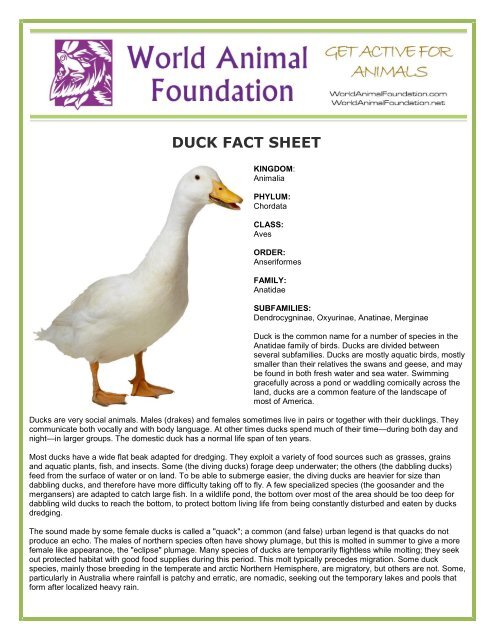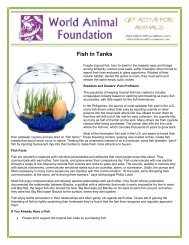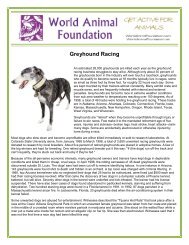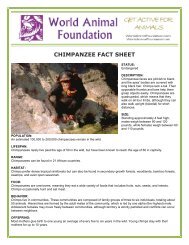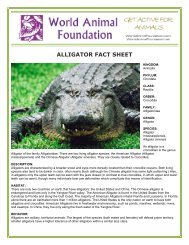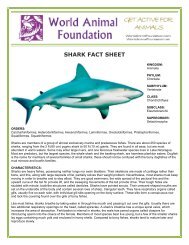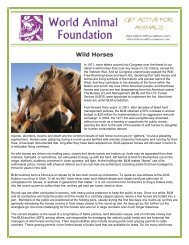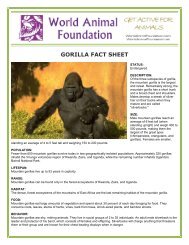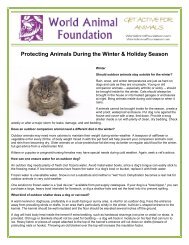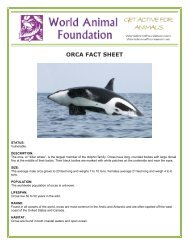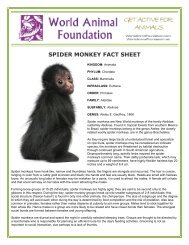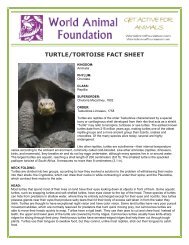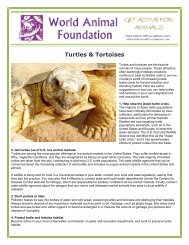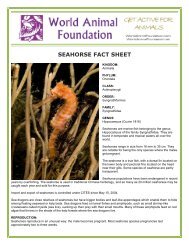DUCK FACT SHEET - World Animal Foundation
DUCK FACT SHEET - World Animal Foundation
DUCK FACT SHEET - World Animal Foundation
You also want an ePaper? Increase the reach of your titles
YUMPU automatically turns print PDFs into web optimized ePapers that Google loves.
<strong>DUCK</strong> <strong>FACT</strong> <strong>SHEET</strong><br />
KINGDOM:<br />
<strong>Animal</strong>ia<br />
PHYLUM:<br />
Chordata<br />
CLASS:<br />
Aves<br />
ORDER:<br />
Anseriformes<br />
FAMILY:<br />
Anatidae<br />
SUBFAMILIES:<br />
Dendrocygninae, Oxyurinae, Anatinae, Merginae<br />
Duck is the common name for a number of species in the<br />
Anatidae family of birds. Ducks are divided between<br />
several subfamilies. Ducks are mostly aquatic birds, mostly<br />
smaller than their relatives the swans and geese, and may<br />
be found in both fresh water and sea water. Swimming<br />
gracefully across a pond or waddling comically across the<br />
land, ducks are a common feature of the landscape of<br />
most of America.<br />
Ducks are very social animals. Males (drakes) and females sometimes live in pairs or together with their ducklings. They<br />
communicate both vocally and with body language. At other times ducks spend much of their time—during both day and<br />
night—in larger groups. The domestic duck has a normal life span of ten years.<br />
Most ducks have a wide flat beak adapted for dredging. They exploit a variety of food sources such as grasses, grains<br />
and aquatic plants, fish, and insects. Some (the diving ducks) forage deep underwater; the others (the dabbling ducks)<br />
feed from the surface of water or on land. To be able to submerge easier, the diving ducks are heavier for size than<br />
dabbling ducks, and therefore have more difficulty taking off to fly. A few specialized species (the goosander and the<br />
mergansers) are adapted to catch large fish. In a wildlife pond, the bottom over most of the area should be too deep for<br />
dabbling wild ducks to reach the bottom, to protect bottom living life from being constantly disturbed and eaten by ducks<br />
dredging.<br />
The sound made by some female ducks is called a "quack"; a common (and false) urban legend is that quacks do not<br />
produce an echo. The males of northern species often have showy plumage, but this is molted in summer to give a more<br />
female like appearance, the "eclipse" plumage. Many species of ducks are temporarily flightless while molting; they seek<br />
out protected habitat with good food supplies during this period. This molt typically precedes migration. Some duck<br />
species, mainly those breeding in the temperate and arctic Northern Hemisphere, are migratory, but others are not. Some,<br />
particularly in Australia where rainfall is patchy and erratic, are nomadic, seeking out the temporary lakes and pools that<br />
form after localized heavy rain.
In many areas, wild ducks of various species (including ducks farmed and released into the wild) are hunted for food or<br />
sport, by shooting, or formerly by decoys. Ducks and geese are wild animals, but they have domesticated counterparts<br />
who are raised for their eggs and meat, down and feathers. They're less commonly known as farm animals, yet they can<br />
certainly fall within this category.<br />
URBAN <strong>DUCK</strong>S:<br />
Each year, people are amazed to see ducks and ducklings in the most<br />
unlikely places, such as walking single-file through city streets or nesting<br />
under bank teller windows! Luckily, ducklings are precocious and mature<br />
quickly. Ducks commonly nest in poor spots. These nests may fall prey<br />
to cats, dogs, or human malice. However, moving the eggs and nest is<br />
not only illegal according to federal law, but also the parents usually<br />
won't follow it. It's usually best to leave the nest alone. If ducklings are<br />
beginning to scatter, or you're not sure how long they've been alone, put<br />
a plastic laundry basket over them, upside down, to contain them while<br />
waiting for the mother to return. She will see them through the lattice<br />
sides of the basket and make contact. If she returns, slowly approach<br />
and overturn the basket so she can collect her young.<br />
If a duckling was left behind for a while and his origin is unknown, i.e. fished out of storm drain or spillway, you can<br />
contain the duckling with an upside-down laundry basket (as described above) and monitor to see if the mother returns. If<br />
she doesn't come back after 4-8 hours, call your local fish and game agency to locate a wildlife rehabilitator. These are<br />
tough judgment calls. If you need to hold the duckling(s) in captivity for a few hours, DO NOT give them water to swim in<br />
because ducklings are not waterproof until they're older. They may become chilled and die. Just give them a shallow pan<br />
of water (to drink) and some crushed, non-sugary cereal like Cheerios.<br />
You can shepherd ducks out of an area by creating a "moving wall". Have people hold sheets between them and move<br />
behind the ducks, forcing them to walk in the desired direction. However, consider waiting to move them out because the<br />
young may be vulnerable.<br />
FOIE GRAS:<br />
The methods used to turn duck and goose livers into the "delicacy" known as pâté de foie gras are anything but delicate.<br />
Foie gras is a French term meaning "fatty liver" and it is produced by force-feeding birds. The ducks and geese force-fed<br />
for foie gras are compelled to consume much more high-energy food—mostly corn—than they would eat voluntarily. This<br />
damages their liver and often kills them. The Scientific Committee on <strong>Animal</strong> Health and Welfare for the European Union<br />
found many examples of abuse as a result of force-feeding, including:<br />
Birds are routinely confined to small cages or crowded pens.<br />
Birds are force-fed tremendous amounts of feed via a 12 to 16-inch plastic or metal tube, which is shoved down<br />
their throats and attached to a pressurized pump.<br />
The force-feeding may be performed twice daily for up to two weeks for ducks and three to four times daily, for up<br />
to 28 days for geese.<br />
Force-feeding causes the liver to increase in size about 6-10 times compared to the normal size for a bird.<br />
Increased liver size forces the abdomen to expand, which makes moving difficult and painful. An enlarged<br />
abdomen increases the risk of damage to the stretched tissue of the lower part of the esophagus.<br />
Force-feeding results in accumulated scar tissue in the esophagus.<br />
The liver can be easily damaged by even minor trauma.<br />
In 1992, the HSUS sent a veterinarian to investigate a New York State foie gras producer, which resulted in a police raid<br />
and cruelty charges against the farm. Necropsies taken of the dead birds revealed many painful conditions: The force-fed<br />
birds had chronic heart disorders; ruptured liver cell membranes; cirrhosis; traumatic esophagitis; and lesions in their<br />
gizzards and intestines. Dead birds were found with food filling their esophagi and spilling out of their nostrils.<br />
Ducks and geese are social animals who suffer when confined in individual cages. The confinement also can lead to<br />
lesions of the sternum and bone fractures, as well as foot injuries from the cage floors. Ducks and geese also suffer when<br />
they're not allowed enough water to swim and preen, which they do naturally in the wild.<br />
Originally, all foie gras came from France, but now the United States has gotten into this cruel niche industry. Next time<br />
you go into a store or restaurant that sells foie gras, please let them know that a product that comes from force-feeding<br />
ducks and geese is more than you can stomach.


